Comparison of the Spray Effects of Air Induction Nozzles and Flat Fan Nozzles Installed on Agricultural Drones
Abstract
:1. Introduction
2. Materials and Methods
2.1. Experimental Site
2.2. Equipment
2.3. Evaluation of Spray Coverage and Penetration
2.4. Efficacy Analysis
3. Results and Discussion
3.1. Coverage and Penetration Ratio of Spray
3.2. Control Efficacy
4. Conclusions
- For both crops, coverage was more than 2.3 times higher when using AI nozzles compared with that when using flat fan nozzles. The larger size droplets of the AI nozzle apparently reduced drift, which was attributed to increased deposition of the sprayed droplets. A two-way analysis of variance showed that the effect of the nozzle on the coverage was significant (p < 0.05). For the effect of the plant on coverages, there was no significant difference.
- The penetration ratios of both nozzles were analyzed. A two-way analysis of variance showed no significant difference due to the treatment method. It seems that weather conditions may have affected the results of the experiment. Previous studies of vertically growing maize, which has a similar morphology to rice, have yielded different results than this study, and additional analysis is required.
- The crop production rate was investigated. Duncan’s test showed no significant difference between the experimental groups. Environmental and genetic factors seem to have influenced production. Also, it seemed that the decreased surface area reduced the effectiveness.
- For the control efficacy, Duncan’s test showed no significant difference between the experimental groups. As the results of the production investigation, similar PR values between treatments made no difference in control efficacy.
- When measuring aerial spray performance, penetration rates must be measured at the same time.
Author Contributions
Funding
Institutional Review Board Statement
Informed Consent Statement
Data Availability Statement
Conflicts of Interest
References
- UN. World Population Prospects: Summary of Results; UN DESA/POP/2022/TR/NO. 3; UN: New York, NY, USA, 2022. [Google Scholar]
- Hunter, M.C.; Smith, R.G.; Schipanski, M.E.; Atwood, L.W.; Mortensen, D.A. Agriculture in 2050: Recalibrating Targets for Sustainable Intensification. BioScience 2017, 67, 386–391. [Google Scholar] [CrossRef]
- Oerke, E.C. Crop losses to pests. J. Agric. Sci. 2005, 144, 31–43. [Google Scholar] [CrossRef]
- Skendžić, S.; Zovko, M.; Živković, I.P.; Lešić, V.; Lemić, D. The Impact of Climate Change on Agricultural Insect Pests. Insects 2021, 12, 440. [Google Scholar] [CrossRef]
- FAO. World Food and Agriculture–Statistical Yearbook 2022; FAO: Rome, Italy, 2022. [Google Scholar]
- Giles, D.K.; Akesson, N.B.; Yates, W.E. Pesticide Application Technology: Research and Development and the Growth of the Industry. Trans. ASABE 2008, 51, 397–403. [Google Scholar] [CrossRef]
- OECD. State of the Knowledge—Literature Review on Unmanned Aerial Spray Systems in Agriculture; OECD: Paris, France, 2021. [Google Scholar]
- Hanif, A.S.; Han, X.; Yu, S.-H. Independent Control Spraying System for UAV-Based Precise Variable Sprayer: A Review. Drones 2022, 6, 383. [Google Scholar] [CrossRef]
- Koo, Y. Nozzle Pressure Response Characteristics of Variable Rate System for Unmanned Aerial Applications. J. Biosyst. Eng. 2019, 44, 1–11. [Google Scholar] [CrossRef]
- Chen, P.; Douzals, J.P.; Lan, Y.; Cotteux, E.; Delpuech, X.; Pouxviel, G.; Zhan, Y. Characteristics of unmanned aerial spraying systems and related spray drift: A review. Front. Plant Sci. 2022, 13, 870956. [Google Scholar] [CrossRef]
- Kim, J.; Kim, S.; Ju, C.; Son, H.I. Unmanned Aerial Vehicles in Agriculture: A Review of Perspective of Platform, Control, and Applications. IEEE Access 2019, 7, 105100–105115. [Google Scholar] [CrossRef]
- DIS 23117-1; Agricultural and Forestry Machinery—Unmanned Aerial Spraying Systems—Environmental Requirements. ISO: Geneva, Switzerland, 2021.
- Chen, H.; Lan, Y.; Fritz, B.K.; Hoffmann, W.C.; Liu, S. Review of agricultural spraying technologies for plant protection using unmanned aerial vehicle (UAV). Int. J. Agric. Biol. Eng. 2021, 14, 38–49. [Google Scholar] [CrossRef]
- Tsouros, D.C.; Bibi, S.; Sarigiannidis, P.G. A Review on UAV-Based Applications for Precision Agriculture. Information 2019, 10, 349. [Google Scholar] [CrossRef]
- Morales-Rodríguez, P.A.; Cano Cano, E.; Villena, J.; López-Perales, J.A. A Comparison between Conventional Sprayers and New UAV Sprayers: A Study Case of Vineyards and Olives in Extremadura (Spain). Agronomy 2022, 12, 1307. [Google Scholar] [CrossRef]
- Wang, L.; Huang, X.; Li, W.; Yan, K.; Han, Y.; Zhang, Y.; Pawlowski, L.; Lan, Y. Progress in Agricultural Unmanned Aerial Vehicles (UAVs) Applied in China and Prospects for Poland. Agriculture 2022, 12, 397. [Google Scholar] [CrossRef]
- Zhang, Y.; Huang, X.; Lan, Y.; Wang, L.; Lu, X.; Yan, K.; Deng, J.; Zeng, W. Development and Prospect of UAV-Based Aerial Electrostatic Spray Technology in China. Appl. Sci. 2021, 11, 4071. [Google Scholar] [CrossRef]
- Xiongkui, H.; Bonds, J.; Herbst, A.; Langenakens, J. Recent development of unmanned aerial vehicle for plant protection in East Asia. Int. J. Agric. Biol. Eng. 2017, 10, 18–30. [Google Scholar]
- Sarri, D.; Martelloni, L.; Rimediotti, M.; Lisci, R.; Lombardo, S.; Vieri, M. Testing a multi-rotor unmanned aerial vehicle for spray application in high slope terraced vineyard. J. Agric. Eng. 2019, 50, 38–47. [Google Scholar] [CrossRef]
- Hussain, S.; Cheema, M.J.; Arshad, M.; Chatta, a.; Latif, M.; Ashraf, S.; Siddique, S. Spray uniformity testing of unmanned aerial spraying system for precise agro-chemical applications. Pak. J. Agric. Sci. 2019, 56, 897–903. [Google Scholar]
- Lee, C.-G.; Yu, S.-H.; Rhee, J.-Y. Effects of Unmanned Aerial Spray System Flight Altitude and Collector Height on Spray Deposition Measured Using a Food Dye Tracer. Agriculture 2023, 13, 96. [Google Scholar] [CrossRef]
- Kirk, I.W. Aerial Spray Drift from Different Formulations of Glyphosate. Trans. ASABE 2000, 43, 555–559. [Google Scholar] [CrossRef]
- DIRECTIVE 2009/128/EC; Establishing a Framework for Community Action to Achieve the Sustainable Use of Pesticides. EU: Brussel, Belgium, 2009; pp. 71–86.
- Hilz, E.; Vermeer, A.W.P. Spray drift review: The extent to which a formulation can contribute to spray drift reduction. Crop. Prot. 2013, 44, 75–83. [Google Scholar] [CrossRef]
- Chen, S.; Lan, Y.; Zhou, Z.; Ouyang, F.; Wang, G.; Huang, X.; Deng, X.; Cheng, S. Effect of Droplet Size Parameters on Droplet Deposition and Drift of Aerial Spraying by Using Plant Protection UAV. Agronomy 2020, 10, 195. [Google Scholar] [CrossRef]
- Zhang, X.-Q.; Song, X.-P.; Liang, Y.-J.; Qin, Z.-Q.; Zhang, B.-Q.; Wei, J.-J.; Li, Y.-R.; Wu, J.-M. Effects of Spray Parameters of Drone on the Droplet Deposition in Sugarcane Canopy. Sugar Tech 2020, 22, 583–588. [Google Scholar] [CrossRef]
- Shouji, C.; Yu, S.-H.; Kang, Y.-H.; Choi, Y.; Dafsari, R.A.; Lee, J. Experimental Analysis of the Downwash Airflow Created by a Single Rotor Blade in Agricultural Drones. J. Biosyst. Eng. 2021, 46, 317–331. [Google Scholar] [CrossRef]
- Wang, X.; He, X.; Song, J.; Wang, Z.; Wang, C.; Wang, S.; Wu, R.; Meng, Y. Drift potential of UAV with adjuvants in aerial applications. Int. J. Agric. Biol. Eng. 2018, 11, 54–58. [Google Scholar] [CrossRef]
- Wang, L.; Xu, M.; Hou, Q.; Wang, Z.; Lan, Y.; Wang, S. Numerical verification on influence of multi-feature parameters to the downwash airflow field and operation effect of a six-rotor agricultural UAV in flight. Comput. Electron. Agric. 2021, 190, 106425. [Google Scholar] [CrossRef]
- Yang, F.; Xue, X.; Cai, C.; Sun, Z.; Zhou, Q. Numerical Simulation and Analysis on Spray Drift Movement of Multirotor Plant Protection Unmanned Aerial Vehicle. Energies 2018, 11, 2399. [Google Scholar] [CrossRef]
- Zhan, Y.; Chen, P.; Xu, W.; Chen, S.; Han, Y.; Lan, Y.; Wang, G. Influence of the downwash airflow distribution characteristics of a plant protection UAV on spray deposit distribution. Biosyst. Eng. 2022, 216, 32–45. [Google Scholar] [CrossRef]
- Yu, S.-H.; Yun, Y.-T.; Choi, Y.; Dafsari, R.A.; Lee, J. Effect of Injection Angle on Drift Potential Reduction in Pesticide Injection Nozzle Spray Applied in Domestic Agricultural Drones. J. Biosyst. Eng. 2021, 46, 129–138. [Google Scholar] [CrossRef]
- Kirk, I.W. Measurement and Prediction of Atomization Parameters from Fixed-Wing Aircraft Spray Nozzles. Trans. ASABE 2007, 50, 693–703. [Google Scholar] [CrossRef]
- Guo, H.; Zhou, J.; Liu, F.; He, Y.; Huang, H.; Wang, H. Application of Machine Learning Method to Quantitatively Evaluate the Droplet Size and Deposition Distribution of the UAV Spray Nozzle. Appl. Sci. 2020, 10, 1759. [Google Scholar] [CrossRef]
- Cavalaris, C.; Karamoutis, C.; Markinos, A. Efficacy of cotton harvest aids applications with unmanned aerial vehicles (UAV) and ground-based field sprayers—A case study comparison. Smart Agric. Technol. 2022, 2, 100047. [Google Scholar] [CrossRef]
- Technologies, T. Catalog 51A-M; TeeJet: Glendale Heights, IL, USA, 2014. [Google Scholar]
- Post, S.L. Drift of Droplets from Air-Induction Nozzles. Trans. ASABE 2019, 62, 1683–1687. [Google Scholar] [CrossRef]
- Matthews, G.A. Developments in application technology. Environmentalist 2008, 28, 19–24. [Google Scholar] [CrossRef]
- Guler, H.; Zhu, H.; Ozkan, H.E.; Derksen, R.C.; Yu, Y.; Krause, C.R. Spray Characteristics and Drift Reduction Potential with Air Induction and Conventional Flat-Fan Nozzles. Trans. ASABE 2007, 50, 745–754. [Google Scholar] [CrossRef]
- Dafsari, R.A.; Khaleghi, M.; Yu, S.-H.; Choi, Y.; Lee, J. Design and Performance Evaluation of Air Induction (AI) Nozzles to Reduce Drift Potential for Agricultural Unmanned Aerial Vehicles (UAVs). J. Biosyst. Eng. 2021, 46, 462–473. [Google Scholar] [CrossRef]
- Lou, Z.; Xin, F.; Han, X.; Lan, Y.; Duan, T.; Fu, W. Effect of Unmanned Aerial Vehicle Flight Height on Droplet Distribution, Drift and Control of Cotton Aphids and Spider Mites. Agronomy 2018, 8, 187. [Google Scholar] [CrossRef]
- Zhu, H.; Dorner, J.W.; Rowland, D.L.; Derksen, R.C.; Ozkan, H.E. Spray Penetration into Peanut Canopies with Hydraulic Nozzle Tips. Biosyst. Eng. 2004, 87, 275–283. [Google Scholar] [CrossRef]
- Zhu, H.; Brazee, R.D.; Fox, R.D.; Derksen, R.C.; Ozkan, H.E. Development of a Canopy Opener to Improve Spray Deposition and Coverage Inside Soybean Canopies: Part 1. Mathematical Models to Assist Opener Development. Trans. ASABE 2008, 51, 1905–1912. [Google Scholar] [CrossRef]
- ANSI/ASAE S572.3; Spray Nozzle Classification by Droplet Spectra. ASABE: St. Joseph, MI, USA, 2020.
- Hofman, V.; Solseng, E. Spray Equipment and Calibration; North Dakota State University: Fargo, ND, USA, 2004. [Google Scholar]
- Turner, C.R.; Huntington, K.A. The use of a water sensitive dye for the detection and assessment of small spray droplets. J. Agric. Eng. Res. 1970, 15, 385–387. [Google Scholar] [CrossRef]
- Cerruto, E.; Manetto, G.; Longo, D.; Failla, S.; Papa, R. A model to estimate the spray deposit by simulated water sensitive papers. Crop. Prot. 2019, 124, 104861. [Google Scholar] [CrossRef]
- Negrisoli, M.M.; Raetano, C.G.; Souza, D.M.d.; e Souza, F.M.S.; Bernardes, L.M.; Del Bem Junior, L.; Rodrigues, D.M.; Sartori, M.M.P. Performance of new flat fan nozzle design in spray deposition, penetration and control of soybean rust. Eur. J. Plant Pathol. 2019, 155, 755–767. [Google Scholar] [CrossRef]
- Hunter, J.E.; Gannon, T.W.; Richardson, R.J.; Yelverton, F.H.; Leon, R.G. Coverage and drift potential associated with nozzle and speed selection for herbicide applications using an unmanned aerial sprayer. Weed Technol. 2020, 34, 235–240. [Google Scholar] [CrossRef]
- Zhang, P.; Deng, L.; Lyu, Q.; He, S.; Yi, S.; Liu, Y.; Yu, Y.; Pan, H. Effects of citrus tree-shape and spraying height of small unmanned aerial vehicle on droplet distribution. Int. J. Agric. Biol. Eng. 2016, 9, 45–52. [Google Scholar] [CrossRef]
- Smith, D.B.; Askew, S.D.; Morris, W.H.; Shaw, D.R.; Boyette, M. Drolet Size and Leaf Morphology Effects on Pesticide Spray Deposition. Trans. ASAE 2000, 43, 255–259. [Google Scholar] [CrossRef]
- Zheng, Y.; Yang, S.; Zhao, C.; Chen, L.; Lan, Y.; Yu, T. Modelling operation parameters of UAV on spray effects at different growth stages of corns. Int. J. Agric. Biol. Eng. 2017, 10, 57–66. [Google Scholar]
- Wang, G.; Lan, Y.; Yuan, H.; Qi, H.; Chen, P.; Ouyang, F.; Han, Y. Comparison of Spray Deposition, Control Efficacy on Wheat Aphids and Working Efficiency in the Wheat Field of the Unmanned Aerial Vehicle with Boom Sprayer and Two Conventional Knapsack Sprayers. Appl. Sci. 2019, 9, 218. [Google Scholar] [CrossRef]
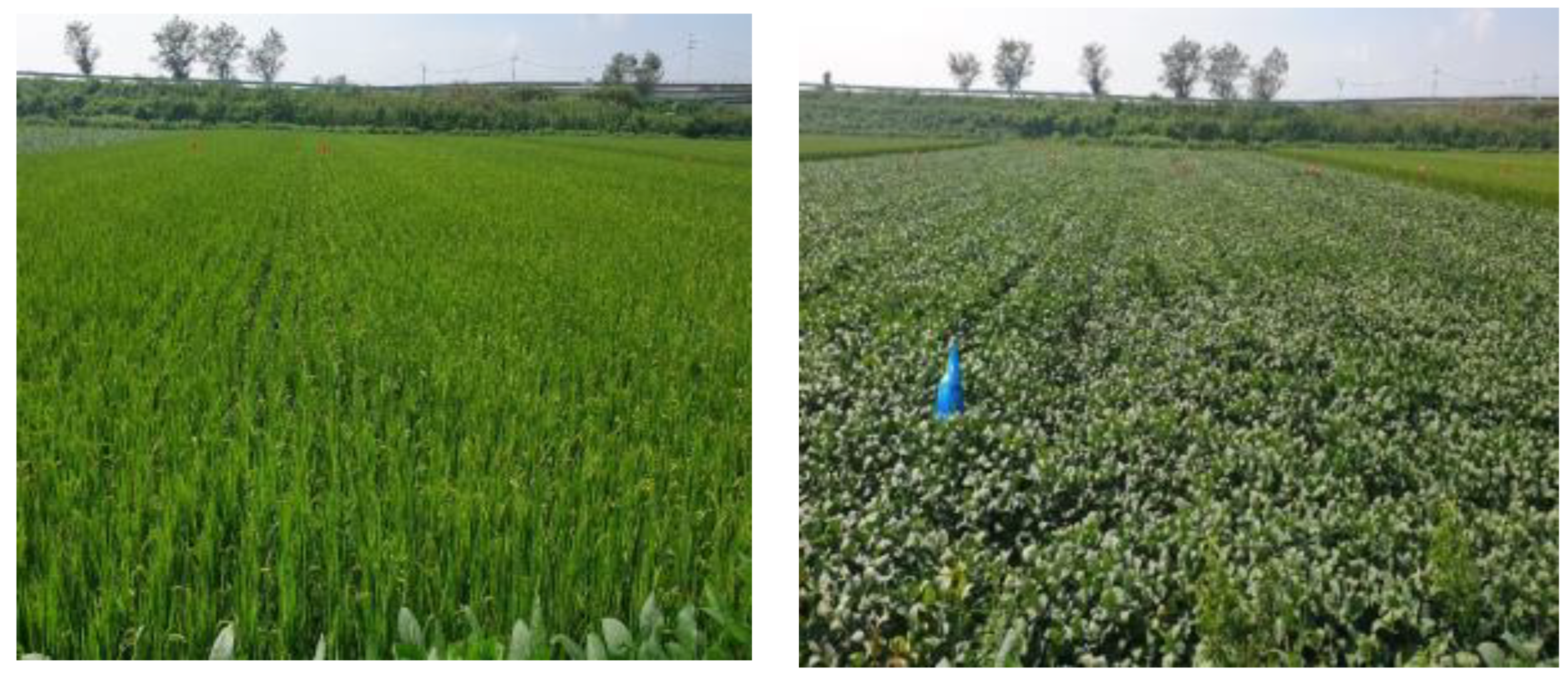
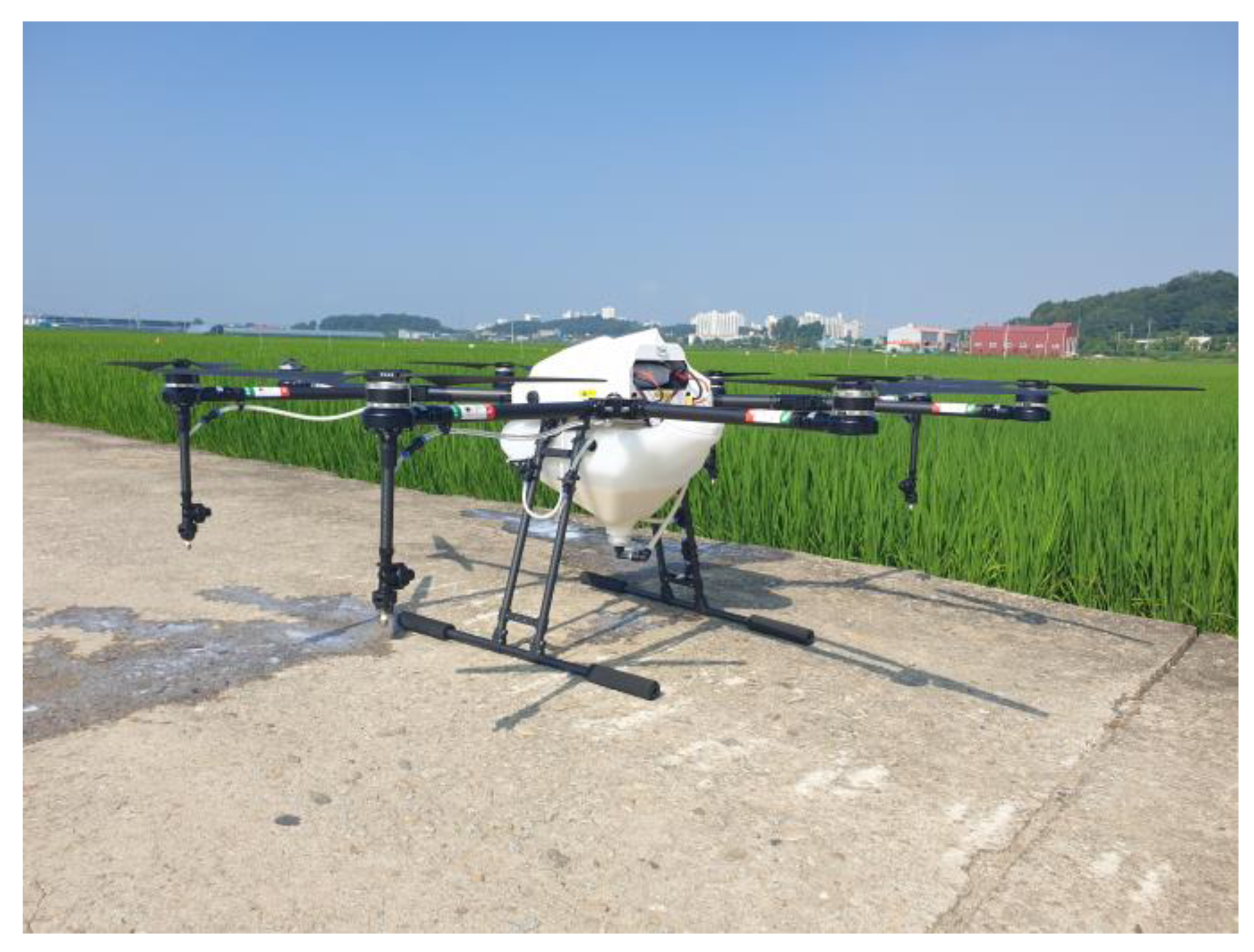
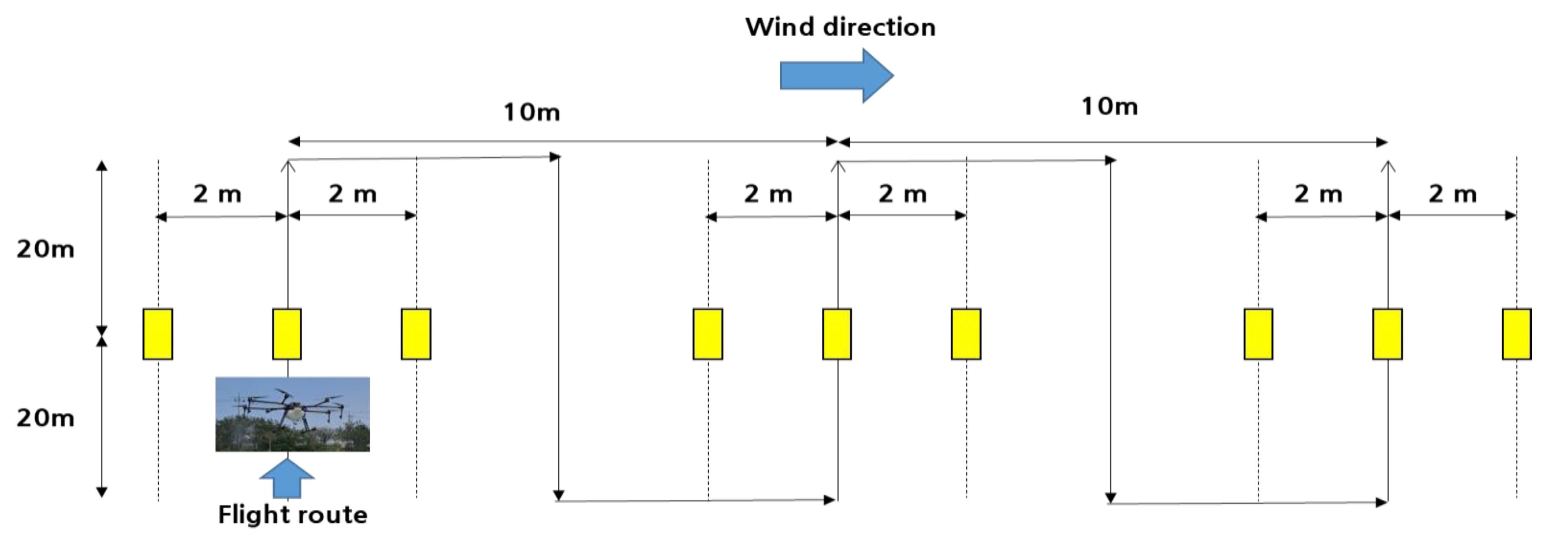
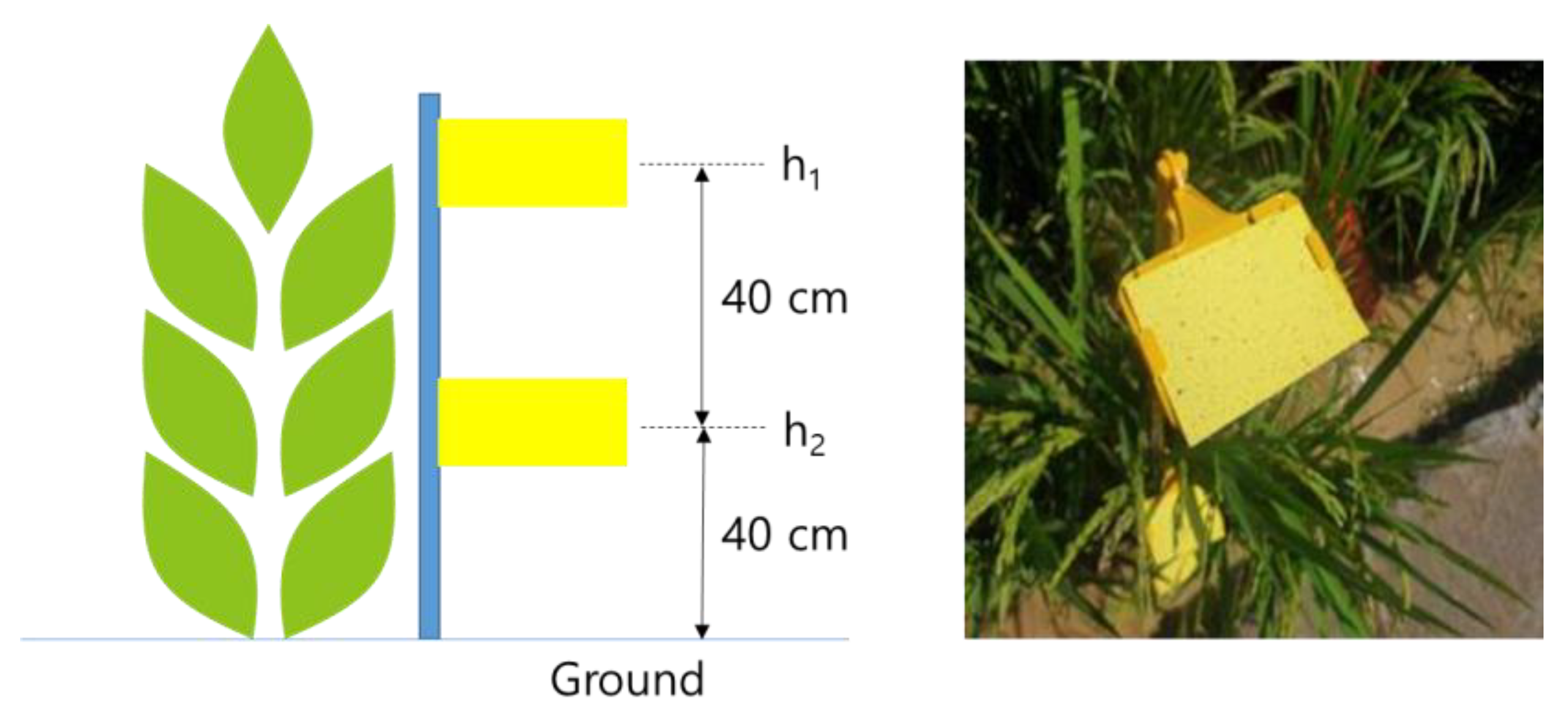
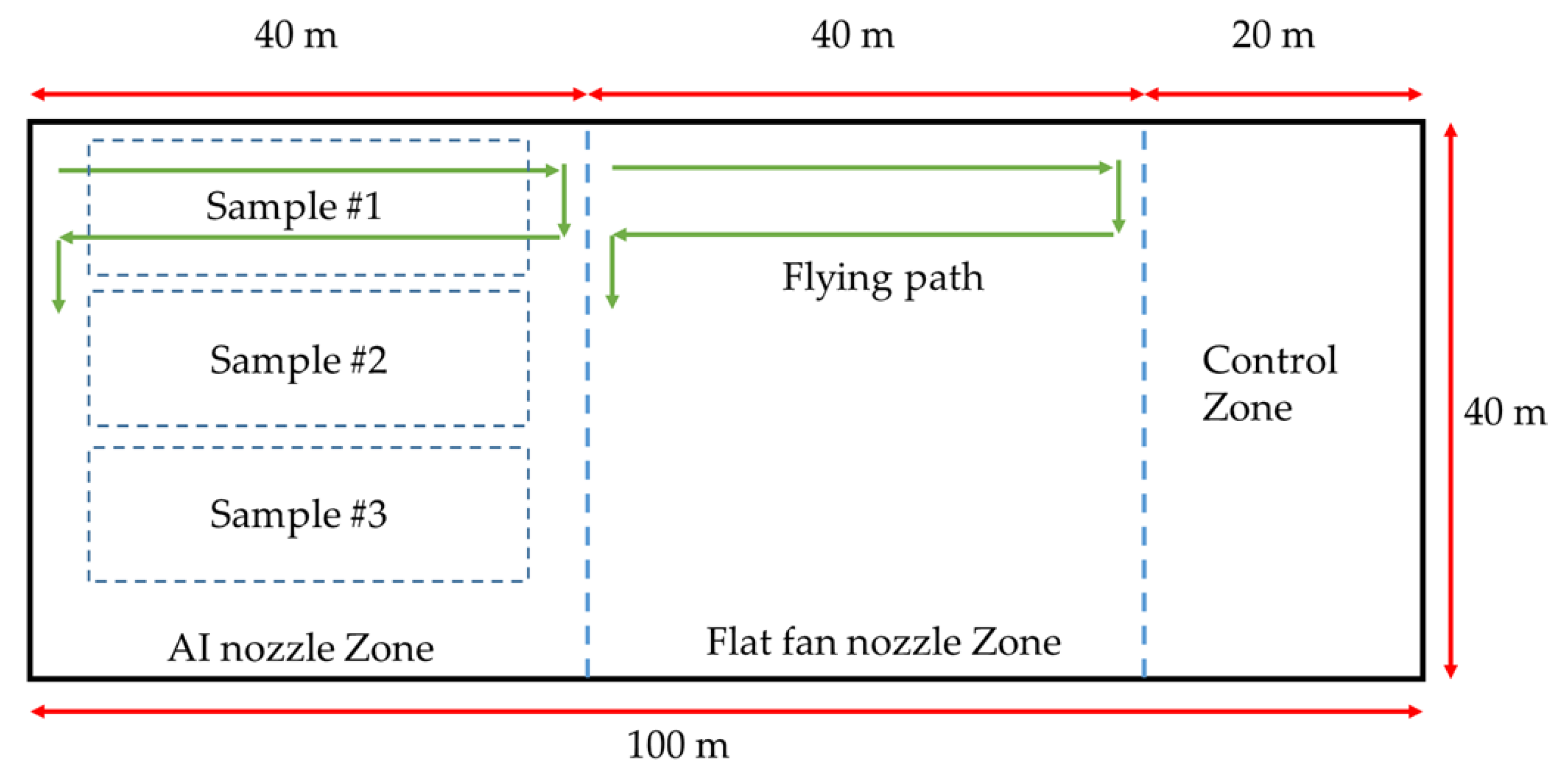
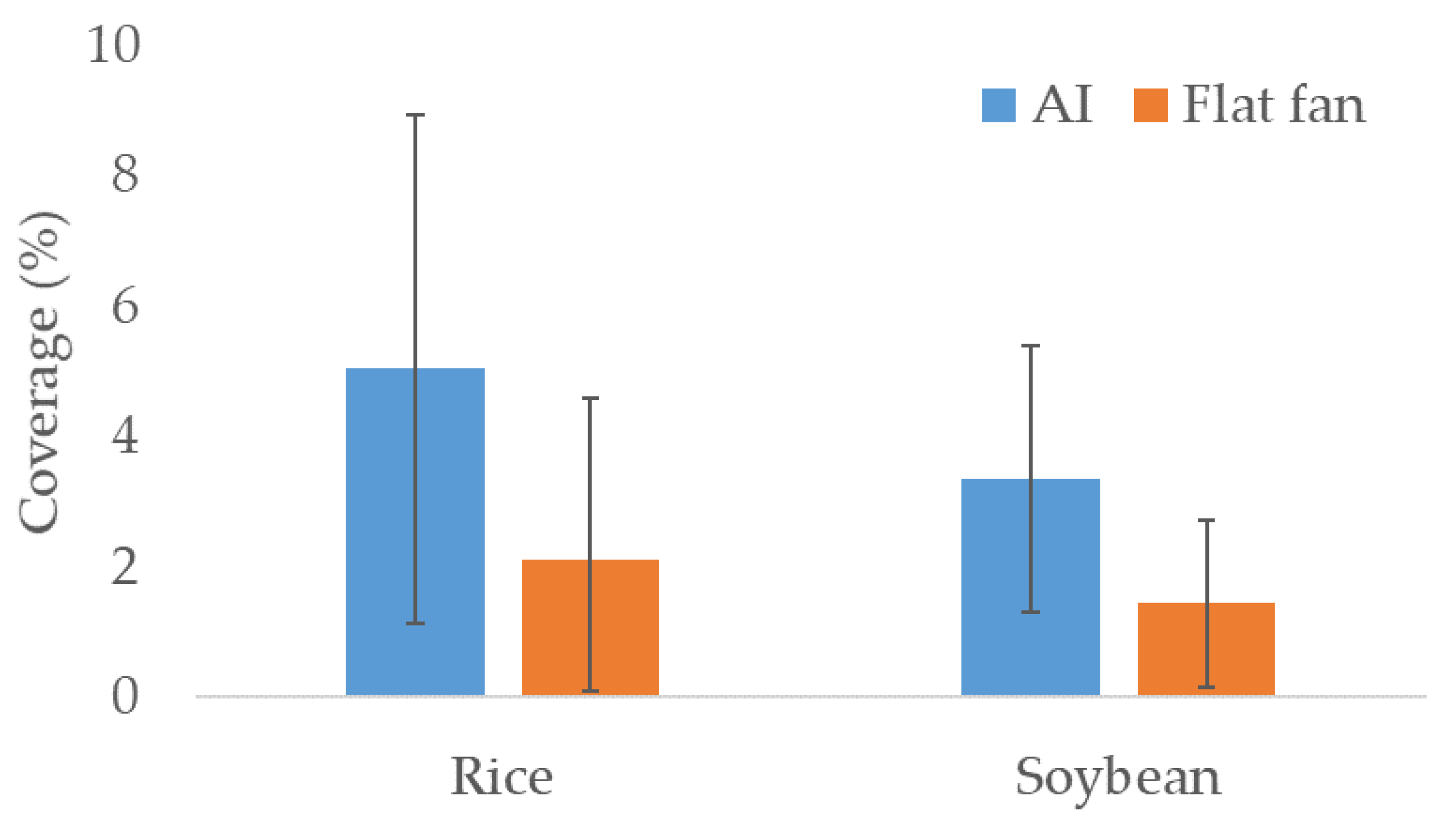
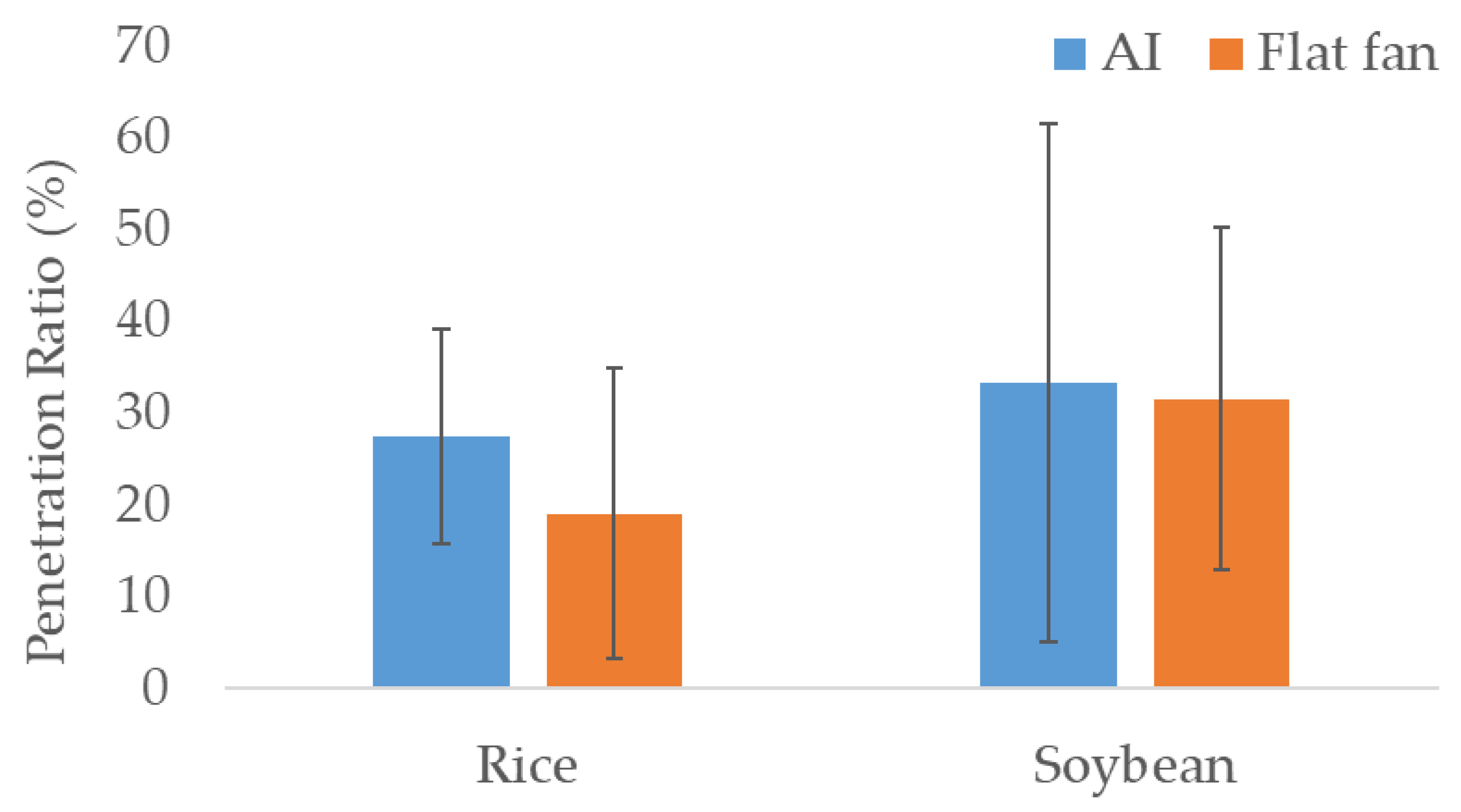
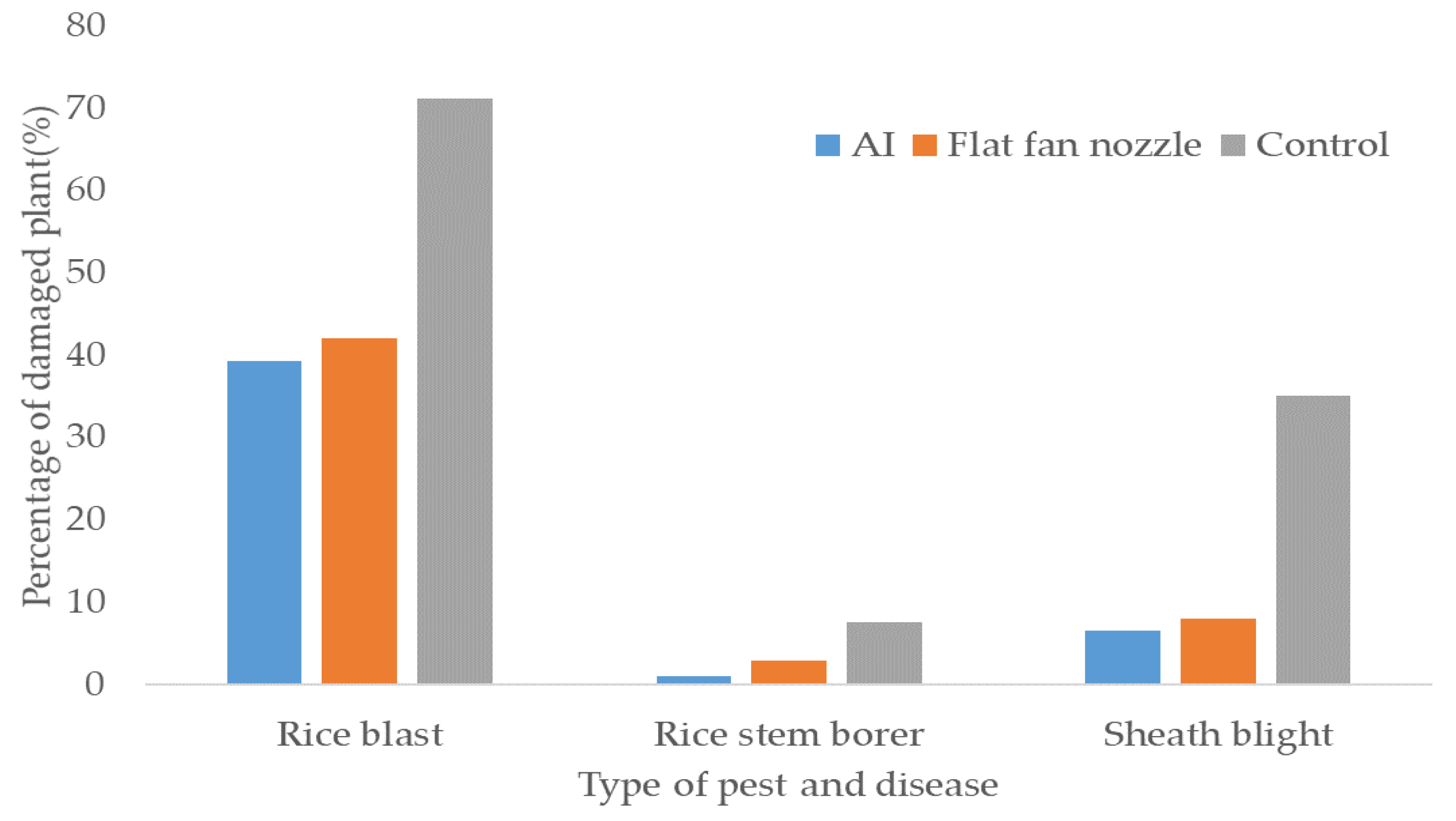
| Parameter | Value |
|---|---|
| Dimension (mm) | 2075 (W) × 2075 (L) × 700 (H) |
| Total weight (kg) | 14.5 |
| Flight controller | K++ |
| Maximum thrust (kg/rotor) | 5.1 |
| Maximum takeoff weight (kg) | 24.9 |
| Rated pressure (MPa) | 0.8 |
| Rated flow (L/min) | 5.5 |
| Capacity of solution tank (L) | 10 |
| Spray width(m) | 4 |
| Number of used nozzles | 2 |
| Nozzle | Pressure (MPa) | Spray Angle | VMD (μm) |
|---|---|---|---|
| XR110015 | 0.28 | 110 | 189 |
| AI | 0.28 | 110 | 450 |
| Spraying | Date | Plant Protection Product | Dosage |
|---|---|---|---|
| Rice | |||
| 1 | 16 July | 20% Ferimzone + 1.5% Fluxapyroxad + 8% Etofenprox + 3% Metaflumizone | 0.44 L |
| 2 | 5 August | 6% Azoxystrobin + 5% Validamycin A + 10% Etofenprox | 0.44 L |
| 3 | 12 August | 8% Etofenprox + 3% Metaflumizone + 30% Ferimzone + 3% Thifluzamide | 0.44 L |
| Soybean | |||
| 1 | 5 July | 8% Etofenprox + 3% Metaflumizone | 0.44 L |
| 2 | 5 August | 6% Azoxystrobin + 5% Validamycin A + 10% Etofenprox | 0.44 L |
| 3 | 12 August | 8% Etofenprox + 3% Metaflumizone + 13.6% Boscalid + 8% Pyraclostrobin | 0.44 L |
| Factor | Degree of Freedom | Sum of Squares | F | p-Value |
|---|---|---|---|---|
| Plant | 1 | 6.15 | 0.764 | 0.3904 |
| Nozzle | 1 | 43.9 | 5.450 | 0.0279 |
| Plant × Nozzle | 1 | 1.92 | 0.238 | 0.6300 |
| Factor | Degree of Freedom | Sum of Squares | F | p-Value |
|---|---|---|---|---|
| Plant | 1 | 1104 | 2.668 | 0.117 |
| Nozzle | 1 | 398 | 0.962 | 0.337 |
| Plant × Nozzle | 1 | 2 | 0.005 | 0.947 |
| Rice (g/m2) | Soybean (g/m2) | |
|---|---|---|
| AI nozzle | 465a | 324a |
| Flat fan nozzle | 449a | 309a |
| Control | 322b | 240b |
| Damaged Leaf Ratio | Damaged Grain Ratio | |||
|---|---|---|---|---|
| Disease (%) | Pest (%) | Disease (%) | Pest (%) | |
| AI nozzle | 0.5a | 11.8a | 2.2a | 3.6a |
| Flat fan nozzle | 0.7a | 15.9a | 2.4a | 4.7a |
| Control | 2.3b | 49.7b | 8.0b | 18.4b |
Disclaimer/Publisher’s Note: The statements, opinions and data contained in all publications are solely those of the individual author(s) and contributor(s) and not of MDPI and/or the editor(s). MDPI and/or the editor(s) disclaim responsibility for any injury to people or property resulting from any ideas, methods, instructions or products referred to in the content. |
© 2023 by the authors. Licensee MDPI, Basel, Switzerland. This article is an open access article distributed under the terms and conditions of the Creative Commons Attribution (CC BY) license (https://creativecommons.org/licenses/by/4.0/).
Share and Cite
Yu, S.-H.; Kang, Y.; Lee, C.-G. Comparison of the Spray Effects of Air Induction Nozzles and Flat Fan Nozzles Installed on Agricultural Drones. Appl. Sci. 2023, 13, 11552. https://doi.org/10.3390/app132011552
Yu S-H, Kang Y, Lee C-G. Comparison of the Spray Effects of Air Induction Nozzles and Flat Fan Nozzles Installed on Agricultural Drones. Applied Sciences. 2023; 13(20):11552. https://doi.org/10.3390/app132011552
Chicago/Turabian StyleYu, Seung-Hwa, Yeongho Kang, and Chun-Gu Lee. 2023. "Comparison of the Spray Effects of Air Induction Nozzles and Flat Fan Nozzles Installed on Agricultural Drones" Applied Sciences 13, no. 20: 11552. https://doi.org/10.3390/app132011552
APA StyleYu, S.-H., Kang, Y., & Lee, C.-G. (2023). Comparison of the Spray Effects of Air Induction Nozzles and Flat Fan Nozzles Installed on Agricultural Drones. Applied Sciences, 13(20), 11552. https://doi.org/10.3390/app132011552








